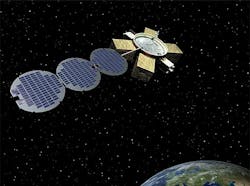Air Force Research Lab taps Raytheon to build hypertemporal multispectral space sensor
Officials of the Space Vehicles Directorate of the Air Force Air Force Research Laboratory's Space Experiments and Programs Branch (AFRL/RVEP) at Kirtland Air Force Base, N.M., announced a $33.7 million five-year contract to Raytheon Wednesday for the hypertemporal imaging space experiment payload.
The electro-optical space instrument that Raytheon will build is to help Air Force researchers improve their understanding of hypertemporal imaging, which involves blending images taken of different spots on the Earth in several different spectral wavelengths at regular intervals over time.
Not only do hypertemporal images give intelligence analysts a look at how light interacts with the scene over many different wavelenghts -- such as infrared, ultraviolet, and visible light -- but also how the scene changes over time.
Related: Raytheon to provide UAV electro-optical targeting systems in $50.2 million contract
Hypertemporal images are taken using several different wavelength bands to extract more information than are available from simple visible-light images, and also use many different time periods to find out how areas behave over time.
The Air Force Hypertemporal Imaging Space Experiment (HTI SpX), for which Raytheon is designing this space instrument, may be using advanced hypertemporal techniques such as principal components analysis and Fourier analysis to help researchers better understand how they can using persistent-surveillance space imagery taken over time.
Air Force researchers are asking Raytheon to build a space sensor able to collect data of a wide range of target signatures in varied background environments. The flight instrument will be compatible with and fly on the Air Force Research Laboratory’s Evolved Expendable Launch Vehicle (EELV) Secondary Adapter (ESPA) Augmented Geostationary Laboratory Experiment (EAGLE).
Spacecraft designers at Orbital Sciences Corp. in Dulles, Va., won a $32 million contract from the Air Force in late 2012 to develop the experimental maneuverable EAGLE spacecraft to host several payloads in low- and geosynchronous orbits.
Related: Raytheon joins DARPA program to develop new kinds of 3D electro-optical imaging sensors
Raytheon will design a stabilized hypertemporal imaging space sensor that is optimized for thermal control of its optics. It will have modular passive or active cryocooling, and will have fast framing capabilities to support frame co-addition for high photoelectron harvesting rates.
Part of the job calls for Raytheon experts to choose focal plane array size and well-depth, aperture size, image stability, and frame rates to ensure the high photoelectron harvesting rates and total collection necessary for hypertemporal imaging. The sensor also will have several different spectral filters.
The contract has options for Raytheon to add a mid-wave infrared (MWIR) and midwave and longwave (M/LWIR) data channels. On this contract Raytheon will do the work in El Segundo, Calif., and should be finished by January 2017.
For more information contact Raytheon Space and Airborne Systems online at www.raytheon.com, or the Air Force Research Lab Space Vehicles Directorate at www.kirtland.af.mil/afrl_vs.
